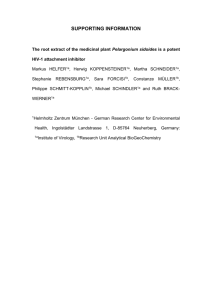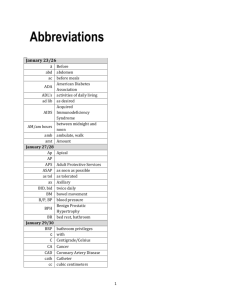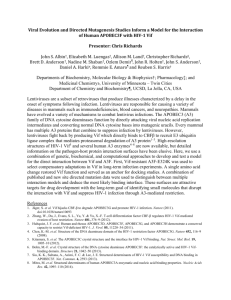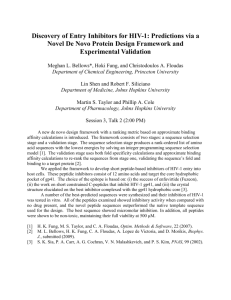Document 13309151
advertisement
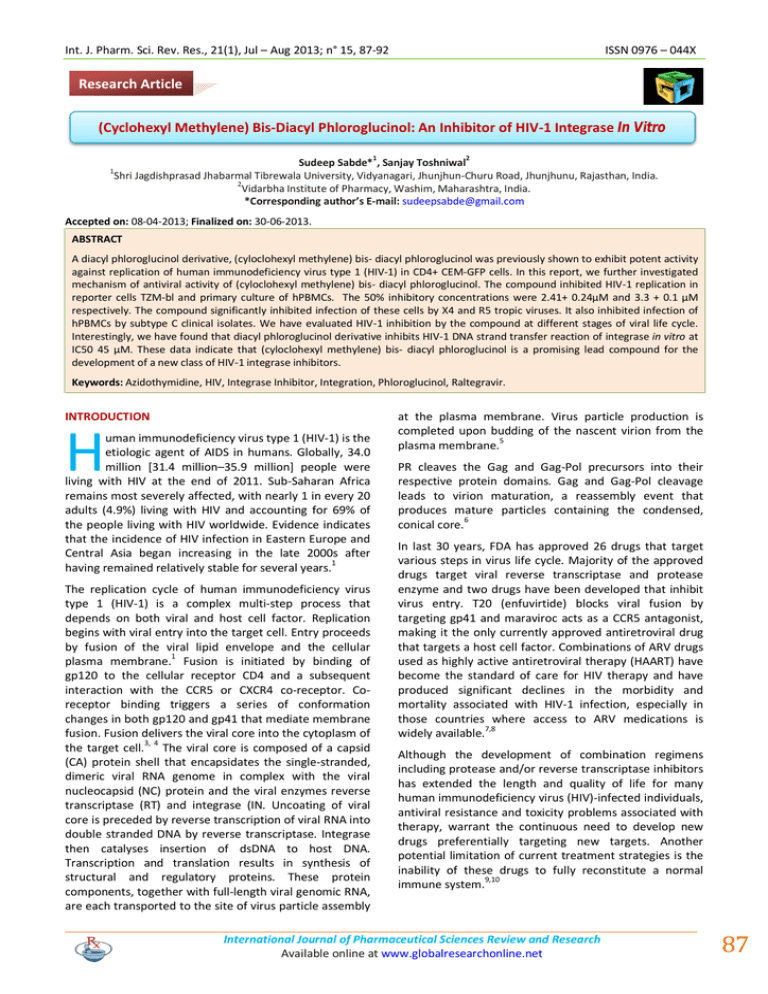
Int. J. Pharm. Sci. Rev. Res., 21(1), Jul – Aug 2013; n° 15, 87-92 ISSN 0976 – 044X Research Article (Cyclohexyl Methylene) Bis-Diacyl Phloroglucinol: An Inhibitor of HIV-1 Integrase In Vitro 1 1 2 Sudeep Sabde* , Sanjay Toshniwal Shri Jagdishprasad Jhabarmal Tibrewala University, Vidyanagari, Jhunjhun-Churu Road, Jhunjhunu, Rajasthan, India. 2 Vidarbha Institute of Pharmacy, Washim, Maharashtra, India. *Corresponding author’s E-mail: sudeepsabde@gmail.com Accepted on: 08-04-2013; Finalized on: 30-06-2013. ABSTRACT A diacyl phloroglucinol derivative, (cyloclohexyl methylene) bis- diacyl phloroglucinol was previously shown to exhibit potent activity against replication of human immunodeficiency virus type 1 (HIV-1) in CD4+ CEM-GFP cells. In this report, we further investigated mechanism of antiviral activity of (cyloclohexyl methylene) bis- diacyl phloroglucinol. The compound inhibited HIV-1 replication in reporter cells TZM-bl and primary culture of hPBMCs. The 50% inhibitory concentrations were 2.41+ 0.24µM and 3.3 + 0.1 µM respectively. The compound significantly inhibited infection of these cells by X4 and R5 tropic viruses. It also inhibited infection of hPBMCs by subtype C clinical isolates. We have evaluated HIV-1 inhibition by the compound at different stages of viral life cycle. Interestingly, we have found that diacyl phloroglucinol derivative inhibits HIV-1 DNA strand transfer reaction of integrase in vitro at IC50 45 µM. These data indicate that (cyloclohexyl methylene) bis- diacyl phloroglucinol is a promising lead compound for the development of a new class of HIV-1 integrase inhibitors. Keywords: Azidothymidine, HIV, Integrase Inhibitor, Integration, Phloroglucinol, Raltegravir. INTRODUCTION H uman immunodeficiency virus type 1 (HIV-1) is the etiologic agent of AIDS in humans. Globally, 34.0 million [31.4 million–35.9 million] people were living with HIV at the end of 2011. Sub-Saharan Africa remains most severely affected, with nearly 1 in every 20 adults (4.9%) living with HIV and accounting for 69% of the people living with HIV worldwide. Evidence indicates that the incidence of HIV infection in Eastern Europe and Central Asia began increasing in the late 2000s after having remained relatively stable for several years.1 The replication cycle of human immunodeficiency virus type 1 (HIV-1) is a complex multi-step process that depends on both viral and host cell factor. Replication begins with viral entry into the target cell. Entry proceeds by fusion of the viral lipid envelope and the cellular 1 plasma membrane. Fusion is initiated by binding of gp120 to the cellular receptor CD4 and a subsequent interaction with the CCR5 or CXCR4 co-receptor. Coreceptor binding triggers a series of conformation changes in both gp120 and gp41 that mediate membrane fusion. Fusion delivers the viral core into the cytoplasm of the target cell.3, 4 The viral core is composed of a capsid (CA) protein shell that encapsidates the single-stranded, dimeric viral RNA genome in complex with the viral nucleocapsid (NC) protein and the viral enzymes reverse transcriptase (RT) and integrase (IN. Uncoating of viral core is preceded by reverse transcription of viral RNA into double stranded DNA by reverse transcriptase. Integrase then catalyses insertion of dsDNA to host DNA. Transcription and translation results in synthesis of structural and regulatory proteins. These protein components, together with full-length viral genomic RNA, are each transported to the site of virus particle assembly at the plasma membrane. Virus particle production is completed upon budding of the nascent virion from the plasma membrane.5 PR cleaves the Gag and Gag-Pol precursors into their respective protein domains. Gag and Gag-Pol cleavage leads to virion maturation, a reassembly event that produces mature particles containing the condensed, conical core.6 In last 30 years, FDA has approved 26 drugs that target various steps in virus life cycle. Majority of the approved drugs target viral reverse transcriptase and protease enzyme and two drugs have been developed that inhibit virus entry. T20 (enfuvirtide) blocks viral fusion by targeting gp41 and maraviroc acts as a CCR5 antagonist, making it the only currently approved antiretroviral drug that targets a host cell factor. Combinations of ARV drugs used as highly active antiretroviral therapy (HAART) have become the standard of care for HIV therapy and have produced significant declines in the morbidity and mortality associated with HIV-1 infection, especially in those countries where access to ARV medications is widely available.7,8 Although the development of combination regimens including protease and/or reverse transcriptase inhibitors has extended the length and quality of life for many human immunodeficiency virus (HIV)-infected individuals, antiviral resistance and toxicity problems associated with therapy, warrant the continuous need to develop new drugs preferentially targeting new targets. Another potential limitation of current treatment strategies is the inability of these drugs to fully reconstitute a normal immune system.9,10 International Journal of Pharmaceutical Sciences Review and Research Available online at www.globalresearchonline.net 87 Int. J. Pharm. Sci. Rev. Res., 21(1), Jul – Aug 2013; n° 15, 87-92 Integrase (IN), was until recently an “orphan” target in terms of approved ARV drugs. This changed in late 2007 with the FDA approval of raltegravir (RAL, MK-0518, 7, Isentress®, Merck Inc.), a strand transfer inhibitor of IN. 11 Over the last decade, there have been extensive studies performed towards finding new drugs to inhibit IN, resulting in a vast number of compounds reported to inhibit IN in biochemical assays. Elvitegravir (EVG; GS9137; Gilead) and S/GSK1349572 (ViiV Healthcare) are the next most advanced antiretroviral drugs (ARVs). However, as reported for other anti-HIV therapeutic compounds, resistance to RAL has been described in vitro and in vivo. This low genetic barrier to resistance, which is a controversial but clinically recognized property, might dampen enthusiasm for the use of raltegravir in a potentially non-adherent population.12-14 Donglei et al. have elaborately reviewed anti-HIV agents from natural resources belonging to several classes including terpenoids, coumarins, alkaloids, polyphenols, tannins and flavonoids.15 Earlier, we reviewed natural products exhibiting anti-HIV activity. Anti- HIV agents from these classes exhibit unique mechanism of action pertaining to their physicochemical properties. These natural product derived compounds can be used in conjunction with existing anti-HIV agents and thus possibility of drug resistance could be minimized in novel formulations both for therapeutic and preventive use.16 Naturally occurring phloroglucinol compounds have shown a diverse range of biological activities including anti-HIV activity. These compounds are known to inhibit HIV reverse transcription.17-19 We recently disclosed our own work in the field by presenting the design, synthesis and anti-HIV-1 activity of a small family of dimeric phloroglucinols. Compound 19 ie (cyclohexyl methylene)-bis- diacyl phloroglucinol showed more than 75% inhibition of HIV-1 in cell based assay and exhibited better safety index than other analogues. However in vitro reverse transcriptase assay it did not show inhibition of reverse transcription. Docking study of this compound indicated that it may inhibit HIV-1 20, 21 integrase. In this study we have assessed anti-HIV-1 activity of (cyclohexyl methylene) bis- diacyl phloroglucinol against different HIV-1 isolates in primary culture and evaluated the mechanism by which it inhibits HIV-1 using cell based and cell free assays. We confirmed that (cyclohexyl methylene) bis-diacyl phloroglucinol inhibits HIV-1 integrase in vitro. MATERIALS AND METHODS Compounds (cyclohexyl methylene) bis- diacyl phloroglucinol (referred 20 as 1 in this paper) was synthesized as reported earlier. Zidovudine was obtained from Sigma Aldrich (USA). ISSN 0976 – 044X Raltegravir was obtained from NIH AIDS Research and Reference Reagent Program, USA. Cells and viruses TZMbl (HeLa CD4+, CCR5+, CXCR4+, LTR-Luc-β-Gal), was obtained through the National Institutes of Health AIDS Research and Reference Reagent Program, USA.22 TZMbl cells were propagated in Dulbecco’s modified Eagle medium (Invitrogen, USA) containing 10% fetal bovine serum (FBS) (Invitrogen, USA) and 0.1% penicillin and streptomycin (Sigma, USA). Human peripheral blood mononuclear cells (hPBMCs) were isolated from healthy blood donors and purified using the Histopaque (Sigma, USA) density gradient centrifugation. The cells were then stimulated with 2µg/ml PHA for further 36h. Viruses HIV-1 CXCR4 tropic molecular clone NL4.3 and IIIB, R5 tropic strains HIV-1 ADA, HIV-1 and JRCSF, X4-R5 dual tropic strains 89.6 and Yu-2 were obtained from NIH AIDS reagent program, USA. HIV-1 Indie C1, a full length molecular clone of HIV-1 subtype C Indian isolate was a kind gift of Dr M Tatsumi, Japan.23 Primary subtype C isolates VB51 and VB52 were obtained from National AIDS Research Institute, India. Cell Viability assay 104 TZMbl cells were seeded in each well of a 96 well plate and incubated overnight in CO2 incubator. To assess toxicity of compounds on PBMCs, 104 cells were added to each well of 96 well plate just before addition of compounds. Viability of TZMbl, and PBMCs was assayed using MTT Kit (Roche) according to the manufacturer’s protocol as described earlier.24,25 In vitro efficacy studies using TZM-bl cells TZM-bl cells express CD4, CXCR4, and CCR5, which render them susceptible to infection, and contain an integrated Escherichia coli lacZ gene and firefly luciferase gene driven by the HIV-1 long terminal repeat (LTR). Upon infection, Tat production from the integrated provirus leads to activation of the reporters, resulting in synthesis of β-galactosidase as well as luciferase in these cells. Infected cells are identified by enzymatic activity measurement at 48h post infection, allowing quantitation 24,26 after a single round of infection, as described earlier. Anti-HIV activity assay in human PBMCs Human peripheral blood mononuclear cell (PBMC) were used for anti-HIV activity assay as described previously.27,28 Briefly, 5 X 106 activated normal human PBMCs were washed twice with serum free RPMI and then with serum free RPMI containing polybrene. Cells were then infected with HIV-1 NL4.3 at a MOI of 0.05. After 4 h of infection in CO2 incubator, cells were washed twice with serum free RPMI to remove unbound virus and then cells were re-suspended in RPMI with 10% FBS and 0.1 % penicillin-streptomycin. Activation stimulation was maintained by the addition of 20 U/ml recombinant International Journal of Pharmaceutical Sciences Review and Research Available online at www.globalresearchonline.net 88 Int. J. Pharm. Sci. Rev. Res., 21(1), Jul – Aug 2013; n° 15, 87-92 human interleukin-2 (Roche, Germany) in to the culture medium. Cells were added to 24 well plates and compounds were added at different concentrations. AZT was used as a positive control. Culture was continued for 7 days. To determine the level of virus inhibition, cell-free supernatant samples were collected for analysis of p24 protein by using HIV-1 p24 antigen core ELISA (Perkin Elmer Life Science, USA). For anti-HIV-1 activity against other X4, R5 and dual tropic viruses same procedure was followed. For infection of PBMCs with primary isolates 5 ng of virus were used to infect 5 X 106 cells. Time of Addition experiment In order to identify the step at which the compound might be inhibiting HIV infection, we have performed infection in TZM-bl cells with addition of compounds at different time points. For this TZM-bl cells were plated at 104 cells /well the day before infection. For pretreatment with virus condition, HIV-1 NL4-3 virus was mixed with compounds and incubated at 37°C in CO2 incubator for 1h in 1.5ml centrifuge tubes. Thereafter, the virus/compound mixture was added to TZMbl cells in 96 well plate and incubated for 4h at 37°C in CO2 incubator. Cells were then washed to remove unbound virus and compounds. Cells were cultured for 48h and then assessed for luciferase activity. Relative Luciferase units were compared between control infected cells and treated infected cells controls to calculate percent inhibition. For during infection condition, virus and compounds were added simultaneously to TZMbl cells and incubated for 4h at 37°C in CO2 incubator. Cells were then washed to remove unbound virus and compounds. Cells were cultured for 48h and then assessed for luciferase activity. For post-infection condition, TZMbl cells were infected with virus (MOI 0.05) for 4h. Cells were then washed to remove unbound virus. Compounds were added to the wells after 0h, 2h, 6h, and 10h of infection. Cells were cultured for 48h and then assessed for luciferase activity. ISSN 0976 – 044X determined. Raltegravir was used as a positive control in this experiment. RESULTS (cyclohexyl methylene) bis- diacyl phloroglucinol displays potent anti-HIV-1 activity in human primary culture and reporter cells We have earlier reported anti-HIV-1 activity of dimeric phloroglucinol in suspension culture of CEM-GFP T cell line.20 In an infected individual, monocytes, macrophages and dendritic cells are primary target of HIV-1. Hence assessment of anti-HIV activity in human primary culture of PBMCs will be a measure of ex vivo efficacy of compound. Reduction in number of T cells triggers the symptomatic phase of HIV infection and further progresses to AIDS. Hence it is essential to treat HIV-1 28 infection of T cells to prevent progression of disease. As shown in figure 1, (cyclohexyl methylene) bis- diacyl phloroglucinol showed 78% of inhibition in infected hPBMCs at 9.73µM. The activity of (cyclohexyl methylene) bis- diacyl phloroglucinol is similar to that observed in CEM-GFP T cell Line. We have also evaluated anti-HIV-1 activity of 1 in adherent cells using TZM-bl reporter cell line which is more susceptible to infection due to presence of CCR5 and CXCR4 coreceptors. In TZM-bl assay, compound 1 inhibited infection of HIV-1 up to 95% at 9.73µM. We have seen that 1 showed significant inhibition of HIV-1 infection of human primary culture and adherent cells (Figure 1). In order to analyze safety index of 1, CC50 and IC50 of compound was assessed in both cultures. As shown in table 1, IC50 of 1 were 3.3 and 2.4uM AZT showed IC50 of 1.1 and 1.3µM in hPBMCs and TZMbl assays respectively. Safety index of 1 for hPBMCs is less than that of TZMbl cells. In vitro Integrase assay In vitro integrase assay was performed to analyze the HIV1 IN inhibition by the compounds using HIV-1 Integrase Assay kit (Xpressbio Life Science Products, USA) according to manufacturer’s protocol. Briefly, Streptavidin coated 96-well plates were coated with a double-stranded HIV-1 LTR U5 donor substrate (DS) oligonucleotide containing an end-labeled biotin. Full-length recombinant HIV-1 integrase protein was then loaded onto this oligo substrate. Compounds were added to the reaction and then a different double-stranded target substrate (TS) oligo containing 30-end modifications was added to the plate. The HIV-1 integrase cleaves the terminal two bases from the exposed 30-end of the HIV-1 LTR DS and then catalyzes a strand-transfer reaction to integrate the DS into the TS. The products of the reaction were detected colorimetrically using an HRP-labeled antibody directed against the TS 30-end modification. Percent inhibition in the integrase assay was calculated. The IC50 values were Figure 1: Inhibition of HIV-1NL4-3 infection. TZM-bl and hPBMCs were infected with 0.05MOI of HIV-1NL4-3 treated with 9.7µM (cyclohexyl methylene) bis- diacyl phloroglucinol and 5 µM AZT. After 48h of infection, TZM-bl cells were lysed and assayed for luciferase activity. Cell free culture supernantants were collected 7 days post infection of hPBMCs and assayed for p24 production by ELISA. Percent inhibition was calculated by comparing infection of treated verses untreated cells. (Cyclohexyl methylene) bis-diacyl phloroglucinol displays anti-HIV activity against different strains of HIV-1 In order to see if the compound is active only against particular virus strain or it inhibits other HIV-1viral International Journal of Pharmaceutical Sciences Review and Research Available online at www.globalresearchonline.net 89 Int. J. Pharm. Sci. Rev. Res., 21(1), Jul – Aug 2013; n° 15, 87-92 isolates, we have assessed inhibition of different virus isolates including one X4 tropic strain IIIB, R5 tropic strains ADA, JRCSF, IndieC1 and dual tropic isolates 89.6 and Yu2 in both TZM-bl cells and human PBMCs by 1. The results are tabulated in Table 2. It showed significant inhibition with all the virus isolates in both TZM-bl and PBMCs, with the range of inhibition varying between 50 to 80%. To be clinically effective, an anti-HIV drug should exhibit potent activity against isolates obtained from HIV ISSN 0976 – 044X infected patients. In order to see effectiveness of this compound against clinical isolates, hPBMCs were infected with subtype C clinical isolates VB51 and VB52. We observed that 1 displayed potent anti-HIV-1 activity against clinical isolates VB51 and VB 52 in hPBMCs culture as shown in figure 2. It showed 83% and 95% inhibition of VB51 and VB52 respectively at 9.73µM. These results suggest that (cyclohexyl methylene) bis- diacyl phloroglucinol has broad spectrum of anti-HIV-1 activity and it is independent of co-receptor usage. Table 1: Cytotoxicity and Anti-HIV-1 activity of (cyclohexyl methylene) bis- diacyl phloroglucinol in primary culture of human peripheral blood mononuclear cells and TZM-bl cells CODE Concentration µM 1 AZT hPBMCs TZM-bl cells IC 50 µM CC 50 µM Safety Index IC 50 µM CC 50 µM Safety Index 9.73 3.3 + 0.1 39.23 + 1.3 11.8 2.41+ 0.24 50.89+ 2.11 21.15 5 1.17 + 0.07 42.8 + 0.3 36.5 1.34 + 0.02 44.06 ± 0.57 32.88 Table 2: Anti-HIv-1 activity of (cyclohexyl methylene) bis- diacyl phloroglucinol against different strains of HIV-1 in TZM-bl and hPBMCs Concentration µM R5 tropic TZM-bl PBMCs TZM-bl PBMCs TZM-bl PBMCs TZM-bl PBMCs YU2 PBMCs 89.6 TZM-bl JRCSF PBMCs Indie C TZM-bl ADA hPBMCs IIIB X4R5 Dual tropic TZM-bl Compounds X4 tropic 1 9.73 9.73 51.8 + 6.3 68 + 3.7 68.5 + 0.6 81.45 + 5.7 62.1 + 1.2 75 + 3.4 66.3 + 1.7 76.5 + 2.1 62.2 + 2.3 68.8 + 2.5 48.2 + 4.6 73.9 + 5.5 AZT 5 5 99.2 + 0.7 92.9 + 5.1 100 92.9 + 2.8 98.+ 0.4 87.1 + 4.4 100 92.9 + 1.9 100 92.5 + 0.7 100 82.8+ 1.7 added before and immediately after infection. When added 2h post infection, it lost activity. AZT displayed Figure 2: Effect on infection of hPBMCs by subtype C clinical isolates. hPBMCs were infected with 5ng of VB51 and VB52 HIV-1 isolates. Cells were treated with 9.7µM (cyclohexyl methylene) bis- diacyl phloroglucinol and 5 µM AZT. 7 days post infection, cell free culture supernatants were collected and assayed for p24 production by ELISA. consistent activity even after 6h post infection. Raltegravir, an integrase inhibitor displayed highest activity when added before and after infection. Its activity is reduced to 42% when added 6h post infection. (cyclohexyl methylene) bisdiacyl phloroglucinol exhibited weak activity than raltegravir. (cyclohexyl methylene) bis- diacyl phloroglucinol and raltegravir showed reduction in anti-HIV-1 activity when added post infection (figure 3) . (cyclohexyl methylene) bis- diacyl phloroglucinol acts at early steps of virus life cycle In order to see at which step 1 inhibits virus infection, we performed time of addition assay. In this assay, 1 was introduced at different stages during and after infection of TZmbl cells. It has been observed that (cyclohexyl methylene) bis- diacyl phloroglucinol is active and inhibit virus infection completely (95%) when Figure 3: Effect of HIV-1 life cycle. TZM-bl cells were treated at pre, during and post infection with (cyclohexyl methylene) bisdiacyl phloroglucinol (9.7µM), AZT (5 µM) and Raltegravir (5 µM). After 48h of infection, cells were lysed and assayed for LTR driven luciferase activity. Relative luciferase units of International Journal of Pharmaceutical Sciences Review and Research Available online at www.globalresearchonline.net 90 Int. J. Pharm. Sci. Rev. Res., 21(1), Jul – Aug 2013; n° 15, 87-92 nontreated and compound treated cells were compared to calculate percent inhibition. (cyclohexyl methylene) bis- diacyl phloroglucinol inhibits HIV-1 integrase in vitro Gupta et al earlier reported that this compound showed good binding interaction with catalytic residues of HIV-1 integrase, in docking study. In order to confirm the observations from docking study and time of addition experiment, we looked for the ability of compounds to inhibit strand transfer reaction of HIV-1 integrase. It showed 50% inhibition of integrase enzyme activity at 45µM. Raltegravir, known to inhibit strand transfer reaction of HIV integrase exhibited 50% inhibition at 12nM. Our data suggest that the compound may act by interfering at the integration step of HIV-1 life cycle. Table 3: Inhibition of HIV-1 DNA strand transfer reaction in vitro by (cyclohexyl methylene) bis- diacyl phloroglucinol Code IC50 1 45 + 1.3 µM Raltegravir 12 + 0.3 nM DISCUSSION Combination of antiretroviral drugs (highly active antiretroviral therapy [HAART]) has changed the outcome of HIV-1 infection, leading to a dramatic reduction in AIDS-related morbidity and mortality.29,30 Unfortunately, complex drug interactions within the HAART schemes, along with complicated dosing schedules, toxicity, and considerable side effects, makes long-term compliance with drug regimens difficult for most patients.10,31 In addition, the high rate of genetic variation of the HIV-1 genome, combined with natural selection under therapy, gives rise to the development and outgrowth of virus variants resistant to one or 32 multiple administered agents. One way to circumvent this problem would be the identification of new targets for drug therapy. In our continous efforts to develop and identify compounds with anti- HIV activity, we have identified (cyclohexyl methylene) bisdiacyl phloroglucinol as potent inhibitor of HIV-1 in cell based assays. Here, we examined the basis of this antiviral activity. The studies presented here provide evidence that (cyclohexyl methylene) bis- diacyl phloroglucinol exerts its effect at the integration step. Our results indicate that 95% inhibition of infection HIV1NL4-3 in a single round of infection of TZMbl cells, was obtained in the presence of 9.7µM of compound compared to the level in control cell cultures. It has shown potent anti-HIV-1 activity in primary culture of human PBMcs also. We have observed that the activity of compound is not just limited to X4 tropic strains but also encompasses dual tropic and R5 tropic laboratory and clinical virus isolates. ISSN 0976 – 044X Compounds like curcumin have been shown to exhibit anti-HIV activity at lower concentration and inhibit integrase at 10 fold high concentration in vitro.32-34 In dissecting specific steps of the early phase of the viral life cycle that might be targeted by this compound, we have shown that it interferes with HIV-1 integrase activities in vitro. The (cyclohexyl methylene) bis- diacyl phloroglucinol exhibits anti-HIV activity in TZMbl tissue culture only if preincubated with virus and added after infection of target cells. Radio labelled assays may help determine whether 1 must enter the cell with the virus or whether intgrase must be inhibited prior to reverse transcription. Such compounds may prove useful in structure-activity relationship studies on HIV IN and may ultimately lead to new classes of potent HIV therapeutics that act at unique sites. The long-term goal of such studies would be the use of HIV IN inhibitors in combination with existing antiviral agents, the PR and RT inhibitors. Acknowledgement: We thank Department of Biotechnology, Govt of India for funding the research. We are also thankful to Lady Tata Memorial Trust, Mumbai, India for a Senior Research Fellowship to Sudeep Sabde. We thank Dr. I P Singh, Dr. K K Bhutani, NIPER Mohali, for timely support and help. Authors are grateful to Dr. Debashish Mitra, NCCS, Pune for his unconditional help in carrying out this work. REFERENCES 1. UNAIDS report on global AIDs epidemic 2012. 2. Doms RW, Moore JP, HIV-1 membrane fusion: targets of opportunity, J. Cell Biol., 151, 2000, F9-14. 3. Ashkenazi A, Merklinger E, Shai Y, Intramolecular interactions within the human immunodeficiency virus-1 gp41 loop region and their involvement in lipid merging Biochemistry, 51, 2012, 6981-6989. 4. Promsri S, Ullmann GM, Hannongbua S, Molecular dynamics simulation of HIV-1 fusion domain-membrane complexes: Insight into the N-terminal gp41 fusion mechanism, Biophys. Chem., 170, 2012 9-16. 5. Adamson CS, Freed EO, Human immunodeficiency virus type 1 assembly, release, and maturation Adv. Pharmacol., 55, 2007, 347-387. 6. Bell NM, Lever AM, HIV Gag polyprotein: processing and early viral particle assembly, Trends Microbiol., 21, 2013 136-144. 7. Baeten J, Celum C, Oral antiretroviral chemoprophylaxis: current status, Curr. Opin. HIV. AIDS, 7, 2012, 514-519. 8. Olender S, Wilkin TJ, Taylor BS, Hammer SM, Advances in antiretroviral therapy, Top. Antivir. Med., 20, 2012, 6186. 9. Eisele E, Siliciano RF, Redefining the viral reservoirs that prevent HIV-1 eradication, Immunity., 37, 2012 377-388. 10. Jones M, Nunez M, Liver toxicity of antiretroviral drugs, Semin. Liver Dis., 32, 2012 167-176. International Journal of Pharmaceutical Sciences Review and Research Available online at www.globalresearchonline.net 91 Int. J. Pharm. Sci. Rev. Res., 21(1), Jul – Aug 2013; n° 15, 87-92 11. Olender S, Wilkin TJ, Taylor BS, Hammer SM, Advances in antiretroviral therapy, Top. Antivir. Med., 20, 2012, 6186. 12. Malet I, Calvez V, Marcelin AG, The future of integrase inhibitors of HIV-1, Curr. Opin. Virol., 2, 2012, 580-587. 13. Mesplede T, Quashie PK, Wainberg MA, Resistance to HIV integrase inhibitors, Curr. Opin. HIV. AIDS, 7, 2012, 401408. 14. Wainberg MA, Mesplede T, Quashie PK, The development of novel HIV integrase inhibitors and the problem of drug resistance, Curr. Opin. Virol., 2, 2012, 656-662. 15. Yu D, Morris-Natschke SL, Lee KH, New developments in natural products-based anti-AIDS research, Med. Res. Rev., 27, 2007, 108-132. 16. Singh IP, Bodiwala HS, Recent advances in anti-HIV natural products, Nat. Prod. Rep., 27, 2010, 1781-1800. 17. Birt DF, Widrlechner MP, Hammer KD, Hillwig ML, Wei J, Kraus GA, Murphy PA, McCoy J, Wurtele ES, Neighbors JD, Wiemer DF, Maury WJ, Price JP, Hypericum in infection: Identification of anti-viral and antiinflammatory constituents, Pharm. Biol., 47, 2009, 774782. 18. Bloor SJ, Antiviral phloroglucinols from New Zealand Kunzea species, J. Nat. Prod., 55, 1992, 43-47. 19. Vlietinck AJ, De BT, Apers S, Pieters LA, Plant-derived leading compounds for chemotherapy of human immunodeficiency virus (HIV) infection, Planta Med., 64, 1998, 97-109. 20. Chauthe SK, Bharate SB, Sabde S, Mitra D, Bhutani KK, Singh IP, Biomimetic synthesis and anti-HIV activity of dimeric phloroglucinols, Bioorg. Med. Chem., 18, 2010, 2029-2036. 21. Gupta P, Kumar R, Garg P, Singh IP, Active site binding modes of dimeric phloroglucinols for HIV-1 reverse transcriptase, protease and integrase, Bioorg. Med. Chem. Lett., 20, 2010, 4427-4431. 22. Platt EJ, Bilska M, Kozak SL, Kabat D, Montefiori DC, Evidence that ecotropic murine leukemia virus contamination in TZM-bl cells does not affect the outcome of neutralizing antibody assays with human immunodeficiency virus type 1, J. Virol., 83, 2009, 82898292. 23. Mochizuki N, Otsuka N, Matsuo K, Shiino T, Kojima A, Kurata T, Sakai K, Yamamoto N, Isomura S, Dhole TN, Takebe Y, Matsuda M, Tatsumi M, An infectious DNA clone of HIV type 1 subtype C, AIDS Res. Hum. Retroviruses, 15, 1999, 1321-1324. ISSN 0976 – 044X 24. Bodiwala HS, Sabde S, Gupta P, Mukherjee R, Kumar R, Garg P, Bhutani KK, Mitra D, Singh IP, Design and synthesis of caffeoyl-anilides as portmanteau inhibitors of HIV-1 integrase and CCR5, Bioorg. Med. Chem., 19, 2011, 1256-1263. 25. Vassilev LT, Kazmer S, Marks IM, Pezzoni G, Sala F, Mischke SG, Foley L, Berthel SJ, Cell-based screening approach for antitumor drug leads which exploits sensitivity differences between normal and cancer cells: identification of two novel cell-cycle inhibitors, Anticancer Drug Des, 16, 2001, 7-17. 26. Takeuchi Y, McClure MO, Pizzato M, Identification of gammaretroviruses constitutively released from cell lines used for human immunodeficiency virus research, J. Virol., 82, 2008, 12585-12588. 27. Slusher JT, Kuwahara SK, Hamzeh FM, Lewis LD, Kornhauser DM, Lietman PS, Intracellular zidovudine (ZDV) and ZDV phosphates as measured by a validated combined high-pressure liquid chromatographyradioimmunoassay procedure, Antimicrob. Agents Chemother., 36, 1992, 2473-2477. 28. Ulrich PP, Busch MP, el-Beik T, Shiota J, Vennari J, Shriver K, Vyas GN, Assessment of human immunodeficiency virus expression in cocultures of peripheral blood mononuclear cells from healthy seropositive subjects, J. Med. Virol., 25, 1988, 1-10. 29. Emamzadeh-Fard S, Fard SE, Seyed Alinaghi S, Paydary K, Adherence to anti-retroviral therapy and its determinants in HIV/AIDS patients: a review, Infect. Disord. Drug Targets., 12, 2012, 346-356. 30. Hargrove JW, Humphrey JH, Mortality among HIVpositive postpartum women with high CD4 cell counts in Zimbabwe, AIDS, 24, 2010, F11-F14. 31. Calza L, Renal toxicity associated with antiretroviral therapy, HIV. Clin. Trials, 13, 2012, 189-211. 32. Michaud V, Bar-Magen T, Turgeon J, Flockhart D, Desta Z, Wainberg MA, The dual role of pharmacogenetics in HIV treatment: mutations and polymorphisms regulating antiretroviral drug resistance and disposition, Pharmacol. Rev., 64, 2012, 803-833. 33. Jordan WC, Drew CR, Curcumin-a natural herb with antiHIV activity, J. Natl. Med. Assoc., 88, 1996, 333. 34. Mazumder A, Raghavan K, Weinstein J, Kohn KW, Pommier Y () Inhibition of human immunodeficiency virus type-1 integrase by curcumin, Biochem. Pharmacol., 49, 1995, 1165-1170. Source of Support: Nil, Conflict of Interest: None. International Journal of Pharmaceutical Sciences Review and Research Available online at www.globalresearchonline.net 92



